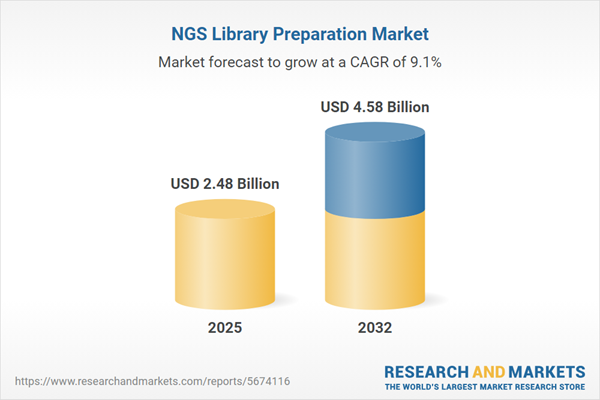Speak directly to the analyst to clarify any post sales queries you may have.
The NGS Library Preparation Market is experiencing accelerated innovation, driven by increased adoption in research and clinical genomics. Organizations are focusing on streamlined workflows, advanced reagent chemistries, and robust supply chains to deliver higher quality sequencing data and respond to evolving global demands.
Market Snapshot: NGS Library Preparation Market Overview
Between 2024 and 2025, the NGS Library Preparation Market is set to rise from USD 2.29 billion to USD 2.48 billion, with a projected compound annual growth rate (CAGR) of 9.07% through 2032, reaching USD 4.58 billion.
Driven by technological advances and automation, this market is diversifying to support genomic research and clinical precision diagnostics on a global scale.Scope & Segmentation
This report provides a detailed segmentation of the NGS library preparation market, highlighting the variety of technologies, regions, components, and end users shaping the industry’s trajectory:
- Component Type: Includes instruments such as automated workstations, library preparation systems, and sequencers; reagents and consumables like beads, buffers, enzymes, and kits; and software and services covering analysis software, consumables support, and setup assistance.
- Sequencing Type: Targeted genome sequencing, whole exome sequencing, and whole genome sequencing enable a broad array of research and clinical applications.
- Workflow Stage: Covers all steps from library amplification and construction to quality control and sample preparation.
- Application: Disease diagnosis, drug and biomarker research, and precision medicine are the primary market drivers.
- End User: Academic and research institutes, contract research organizations, and pharmaceutical and biotechnology companies are key purchasers of NGS library preparation solutions.
- Regional Coverage: Includes Americas (United States, Canada, Mexico, Brazil, Argentina, Chile, Colombia, Peru), Europe, Middle East & Africa (United Kingdom, Germany, France, Russia, Italy, Spain, Netherlands, Sweden, Poland, Switzerland, United Arab Emirates, Saudi Arabia, Qatar, Turkey, Israel, South Africa, Nigeria, Egypt, Kenya), and Asia-Pacific (China, India, Japan, Australia, South Korea, Indonesia, Thailand, Malaysia, Singapore, Taiwan).
- Major Companies Covered: Key industry participants include 10x Genomics, Illumina, Agilent Technologies, Thermo Fisher Scientific, Danaher Corporation, Bio-Rad Laboratories, Eurofins Scientific, Qiagen, Pacific Biosciences, and others.
Key Takeaways
- Library preparation acts as a critical bridge between sample acquisition and sequencing, directly influencing data quality and throughput.
- Workflow automation and digital analytics are being used to reduce error rates and hands-on intervention across diverse sample types, streamlining end-to-end processes.
- Modular laboratory solutions and standardized interfaces increase interoperability and allow laboratories to scale Faster while maintaining regulatory compliance.
- Manufacturers are investing in both reagent innovations and nearshoring strategies to respond to supply disruptions and cost fluctuations, delivering stability to buyers.
- Customizable workflows support the rise of single cell and ultra-low input applications, advancing precision medicine and targeted screening programs.
Tariff Impact on Supply Chain and Costs
The introduction of new United States tariff policies in 2025 has created additional cost pressures for market participants. Import duties on instruments and specialized reagents are prompting organizations to revisit supplier strategies, increase regional manufacturing partnerships, and implement flexible procurement cycles. These shifts are driving the adoption of alternative sourcing options and collaborative assembly lines in tariff-advantaged regions, mitigating the impact of fluctuating regulations.
Methodology & Data Sources
This research leverages a multi-pronged methodology comprising primary interviews with industry executives across instrumentation, reagents, and software, along with comprehensive secondary research from peer-reviewed sources, regulatory filings, and financial reports. Quantitative analysis incorporates shipment data, consumption trends, and user surveys, with regression and scenario modeling used to validate insights and ensure accuracy.
Why This Report Matters
- Enables strategic procurement and investment planning by providing granular segmentation and actionable market intelligence.
- Empowers organizations to navigate disruption by mapping the impact of evolving technologies, regional dynamics, and regulatory policies.
- Supports innovation by benchmarking competitive strengths and highlighting collaboration opportunities across the NGS library preparation market.
Conclusion
This report offers a detailed, unbiased view of the NGS library preparation market, equipping decision makers with the insights needed to optimize operations, manage risks, and foster sustainable growth in an evolving global landscape.
Additional Product Information:
- Purchase of this report includes 1 year online access with quarterly updates.
- This report can be updated on request. Please contact our Customer Experience team using the Ask a Question widget on our website.
Table of Contents
3. Executive Summary
4. Market Overview
7. Cumulative Impact of Artificial Intelligence 2025
Companies Mentioned
The companies profiled in this NGS Library Preparation market report include:- 10x Genomics, Inc.
- Agilent Technologies, Inc.
- Beckman Coulter, Inc.
- Becton, Dickinson and Company
- BGI Genomics Co., Ltd.
- Bio-Rad Laboratories, Inc.
- Danaher Corporation
- DNAnexus, Inc.
- Dnastar, Inc.
- Eurofins Scientific SE
- F. Hoffmann-La Roche Ltd.
- Illumina, Inc.
- Integrated DNA Technologies, Inc.
- Macrogen, Inc.
- Merck KGaA
- Meridian Bioscience, Inc.
- New England Biolabs, Inc.
- NimaGen B.V.
- Pacific Biosciences of California, Inc.
- PerkinElmer, Inc.
- Promega Corporation
- Qiagen GmbH
- Tecan Trading AG
- Thermo Fisher Scientific Inc.
- Twist Bioscience Corporation
Table Information
| Report Attribute | Details |
|---|---|
| No. of Pages | 185 |
| Published | November 2025 |
| Forecast Period | 2025 - 2032 |
| Estimated Market Value ( USD | $ 2.48 Billion |
| Forecasted Market Value ( USD | $ 4.58 Billion |
| Compound Annual Growth Rate | 9.0% |
| Regions Covered | Global |
| No. of Companies Mentioned | 26 |









